In the book, “The Medici Effect: Breakthrough Insights at the Intersection of Ideas, Concepts & Cultures” by Frans Johansson, the author reviews a study on virtual brainstorming and discusses the benefits, finding that his virtual group came up with twice as many ideas as a similar group meeting face-to-face.
While at it, make sure to check our recent post on remote team building activities and games.
Putting your best people in a virtual room for a brainstorming session is one of the fastest and easiest ways to develop new ideas and solve problems. Studies show that remote teams are the future of teamwork. Matching the intention to the outcome is the tricky part. When remote teams need to brainstorm, some potential barriers might exist.
Common problems stem from:
- difficulties in composition of the virtual team, and personal communications
- the mix of attendees, including differences in language, time zone and culture
- a failure to follow a designated process
- the lack of an experienced facilitator
- tools that fail to capture all the ideas
Let’s have a closer look at potential online brainstorming barriers before we move on to rules and techniques. The barriers are broken down according to the P.P.T. framework: People, Processes, & Tools.

Online brainstorming barriers
People
A clear barrier to brainstorming in a virtual environment is the composition of the team and personal communications.
Use virtual team building exercises to overcome this and keep in mind, many virtual teams have better peer-to-peer communications skills in place because they must rely on virtual communications every day as part of their typical work day.
Process
As team members are not located in one room, the online brainstorming session process should be defined and organized well before the meeting begins. By providing a clear agenda, supporting materials and goals for the session in advance, the team engagement will be higher. Participants will have ample time to consider the material beforehand, bringing their individual ideas to the table from the get go.
Another challenge may arise with finding a good facilitator. Ensure you have a facilitator and that this facilitator is experienced with online brainstorming. This person should be a role model for the team, providing guidance and timelines, while maintaining open communications, active listening and correcting bad brainstorming behaviors.
Remote teams may not have the ability or experience to manage this process. For teams inexperienced in brainstorming, and without a facilitator, choosing an “official” facilitator from the group is critical for success. Adopting a “leader” to manage time and act as a guide is highly recommended. Using an online brainstorming tool with guidelines will help you run a brainstorming session, but will not help to replace a facilitator in full.
Tools
Tools and technology can facilitate brainstorming with a remote team. But there are some potential pitfalls to relying on technology alone:
- Using the wrong tool — employing communications platforms that are not a good fit for brainstorming or don’t include mind mapping components;
- Lack of training — if the platform is not intuitive or members are not trained;
- Lack of consistency — total adoption requires consistent and frequent use.
Online brainstorming rules

To overcome these barriers, consider using some of these proven online brainstorming rules, tips and techniques. This will keep the group focused, engaged and will enhance the outcome. Here are our favorites, including some real life examples.
Before the meeting
Rule 1. Invite multiple personalities
First, define which types of personalities you need to invite to your brainstorming session. Groupthink can be a problem for any team. To enhance the outcome, Jack Mannion, Account Manager at Terakeet, has the following rule: “To ignite creativity, make sure to invite people with different mindsets and personalities. This is a great way to ensure you’re avoiding groupthink, and will lead to far more productive and effective conversations.”
Similarly, Jennifer Martin, Founder of Zest Business Consulting says, “… invite into the brainstorming group people from other departments, and varying pay levels, completely unrelated to the problem at hand. Sometimes someone who doesn’t always understand the problem or what isn’t possible can suggest something that everyone else wrote off as impossible or stupid.”
Rule 2. Define the timeframe
Rather than schedule the meeting, define the timeframe and send out the supporting materials and expectations to the chosen participants.
Think of it like a race. Sure, all the action happens between the shot of the gun and the finish line. But it’s the prep work that can make all the difference.
Adam Schnitzler, Chief Creative Officer of The S3 Agency, recommends briefing the team in advance: “Alert the team and give them the brief at least a day before your brainstorm, because most problem solving is done by the unconscious mind, which needs sleep and time to do its thing.”
People get brilliant ideas all the time. By providing the materials and tools for the session ahead of time, participants can experiment, ponder and jot down ideas ahead of time.
When participants arrive with ideas already percolating, you get more out of the meeting and see engagement rise.
Rule 3. The importance of the facilitator
The value that a good facilitator brings to the table for a brainstorming session cannot be underestimated. But if one is not available, ask for volunteers. Nominating even an untrained facilitator for the session will be rewarding. A good facilitator should be able to help brainstorming participants to express their ideas, so attentiveness and good listening skills are the must. The facilitator should not be dominating: they should give a chance to quieter people to contribute and prevent participants from interrupting each other.
So, try giving a chance to one of your colleagues with strong facilitator skills to lead the meeting.
At the beginning of the meeting
Rule 4. Specify the problem
A good rule of thumb is always to define the reason for the session, along with the ultimate goal. Why has the group been called together? Clearly provide a clear problem that the team is going to be tackling and the expected outcomes. This keeps everyone on track and keeps members from going off on non-essential tangents. Jason Parks, President of the Media Captain supports this rule: “I would say too often, people think brainstorming is just going to happen naturally. Putting emphasis behind a brainstorming meeting or session is what will drive the best results.”
Rule 5. Limit time
Set a time limit for the meeting. This has two benefits. Firstly, it creates a sense of urgency for the team and adds some excitement and engagement. This is likely to add to everyone’s sense of creativity. Secondly, setting a time limit helps keep the team on track, according to the goals and plans for how the session is expected to run. You can choose someone from the team to be a timekeeper or simply rely on free software products to do it.
Rule 6. Balance between quality versus quantity
The initial goal of any brainstorming session is to get as many ideas as possible, then prioritize. We follow this ground rule for online brainstorming as well. So we usually start our brainstorming session from divergent thinking to generate as many ideas as possible. Before brainstorming starts, remember the basic guidance:
- There are no bad or wrong ideas or possibilities. Rule out any criticism;
- Out of the box thinking is more than welcome;
- The more ideas the better. Sometimes the craziest ideas prompt the solution that actually gets used.
Encourage all the team members, regardless of location, to work together to create as many ideas as possible. A good tip for generating many high quality ideas is to break a large group into smaller ones.
Nancy Halpern, Principal of KNH Associates has the following advice: “I’ve led many leadership and management teams in brainstorming sessions. Break a larger (20 plus people) into smaller groups like 4 or 5 to do the same exercise — and then compare results that alone will generate new ideas.”
But remember, overall quality depends on how well the session has been designed; having the right participants, communicating meeting goals clearly and in advance, choosing the right facilitator, trying different creativity boosting techniques, etc.
Taking into account the speed of change in the markets and the speed that business running, the result of a brainstorming session should be a list of assessed, quality ideas and the actions to implement these ideas to life. When the divergent thinking stage is over, we can go together to the convergent thinking stage to judge and strengthen those ideas.
The initial groups of people can judge the ideas and write down the actions by themselves, or you can set a separate session with management responsible for the ideas’ implementation. Remind participants and remote team members that there is no reward for whoever comes up with the most ideas. 1-2 great ideas with further actions, formed by input from the entire group is the goal.
Brainstorming Tips
Tip 1. Online brainstorming: use an icebreaker
An icebreaker is an exercise or game that is designed to casually introduce members of a team and warm up the group for the task they are about to embark on. The ice breaker is especially beneficial for remote teams, when team members don’t know each other well or even have never met in person. This exercise is particularly suited to brainstorming.
Planning and preparing a team prior to the meeting for the icebreaker is important. It gives the participants time to prepare so that the “deer in the headlights” and “I’m totally blanking” responses doesn’t occur. In fact, not preparing the team for the icebreaker can lead to more problems, such as shyness or discomfort. Send them a simple explanation along with the meeting materials and some examples of how they can participate.
Tip 2. Prepare a shared space
What is the biggest benefit of actual brainstorming? It is face-to-face interaction, which is a result of sharing a certain space. Location really matters for brainstorming, especially for a virtual one, when your team may be located all over the map. So, where can remote teams brainstorm like they are in one room? We call this a shared space. A shared space is not equal to a meeting room. It includes shared flip charts, chats, shared screens, or a shared online whiteboard.
Look for online whiteboarding tools, such as Miro, that can merge visual and verbal collaboration, opening up participation in a variety of ways so everyone can participate. For members that don’t speak the native language of the meeting, a way to virtually contribute will be very helpful.
You can use online post-it notes, which is a great way to involve introverts! By the way, the number of online post-it notes is unlimited 🙂
Another option is to choose one of the pre-made brainstorming templates to start brainstorming right away. Following this tip also breaks potential problems with attendees not understanding the process that they will follow throughout the meeting.
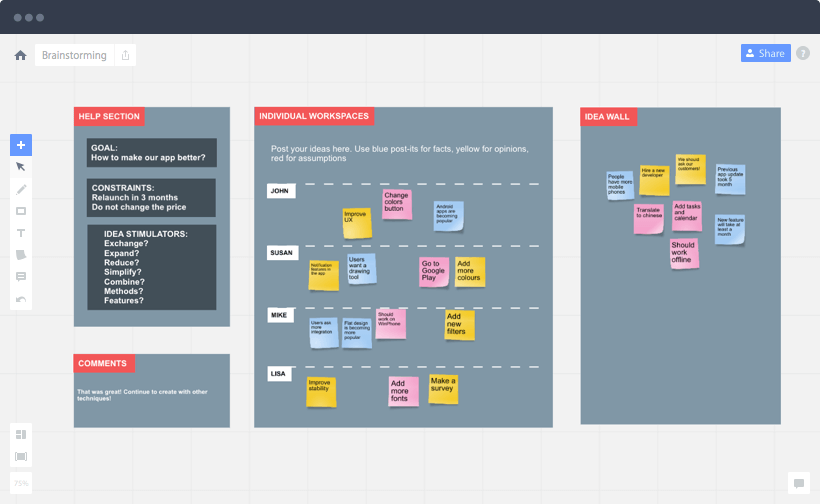
Jordan Scheltgen, Managing Partner, Cave Social, shares his experience using a shared space, “The best technique we’ve implemented actually comes from Buffer. It consists of brainstorming in a Google Doc, with everyone logged in as a guest. This anonymity allows for people to put their ideas into the document without fear of being judged on their idea. This really lets for more creative juices to come out as people start commenting and creating a dialogue with much more vigor.”
These are tips we found useful for our brainstorming sessions, feel free to implement them when necessary. Below are some of the proven techniques to make the most of your remote brainstorming session.
10 techniques for more productive brainstorming

Idea-generation techniques address the potential barriers of processes and tools that we discussed at the beginning of this chapter. The ability to apply these techniques on a platform that everyone can use and feel comfortable on provides tremendous benefits.
Below are 10 brainstorming techniques from the well-known to the niche, which frequent facilitators have found successful for their online brainstorming.
- Mind mapping
Mind mapping is one of the best ways to organize your thoughts and allows categorical idea generation. A mind map is basically a diagram that connects information around a central subject.
For product development or problem solving, the teams will rely on charts or a branch-like structure to plug in and categorize their ideas.
Remote teams can use mind mapping by employing an online whiteboard. It is shared, so everyone can contribute, make changes and see any updates. All the changes are saved in real-time, and there is no need to take pictures of your office whiteboard and send them via email or search for a sticky note somewhere on the floor. Shapes and virtual sticky notes can be moved around as needed to build the mind map.
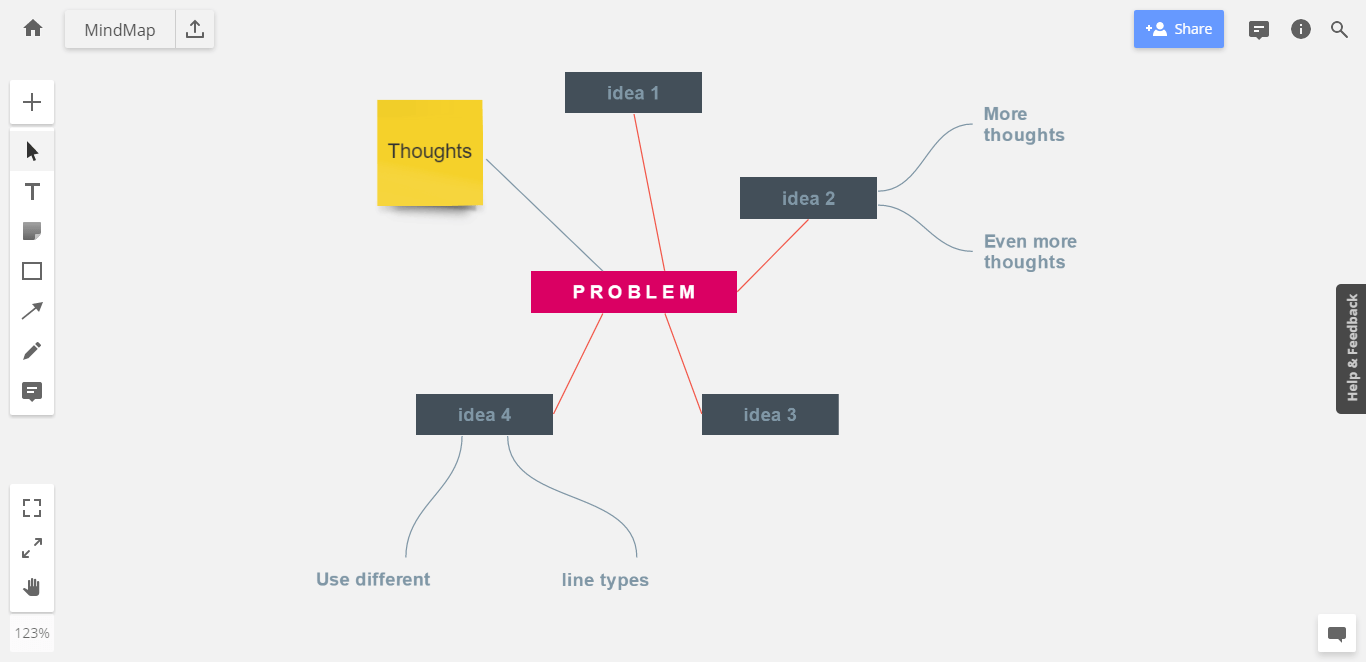
Tony Buzan, the author of a methodology, suggests the following steps for creating your own mind map:
- Start in the center of a blank page (board) — starting in the center gives your brain freedom to spread out in all directions and to express itself more freely and naturally.
- Use an image or picture for your central idea as an image is worth a thousand words and helps you use your imagination. A central image is more interesting, keeps you focused, helps you concentrate.
- Use colors throughout, it adds extra vibrancy and life to your mind map.
- Connect your main branches to the central image and connect your second- and third-level branches to the first and second levels, etc. If you connect the branches, you will understand and remember a lot more easily.
- Use one keyword per line as it gives your mind map more power and flexibility.
- Use images throughout, as a picture worth a thousand words.
2. Brainwriting
The main advantage of brainwriting is to ensure that even the most quiet participants share their ideas. This exercise can be easily adopted to online brainstorming: all you need is a team, ideally 5-6 people, a facilitator, and a collaborative online tool. You can use this Google spreadsheet template or online whiteboard template.
Each participant should have their virtual piece of paper and write down 3 ideas in five minutes on the topic or problem you are brainstorming. Once the five minutes are over, each participant should go to the next participant’s piece of paper and build on the three ideas created by that participant, or to create three new ideas. For this exercise is important to keep writing.
This process is repeated until you come back to your original piece of virtual paper. Then, the ideas need to be gathered and discussed to choose the best one. And don’t forget to write down the actions that need to be done in order to implement these ideas.
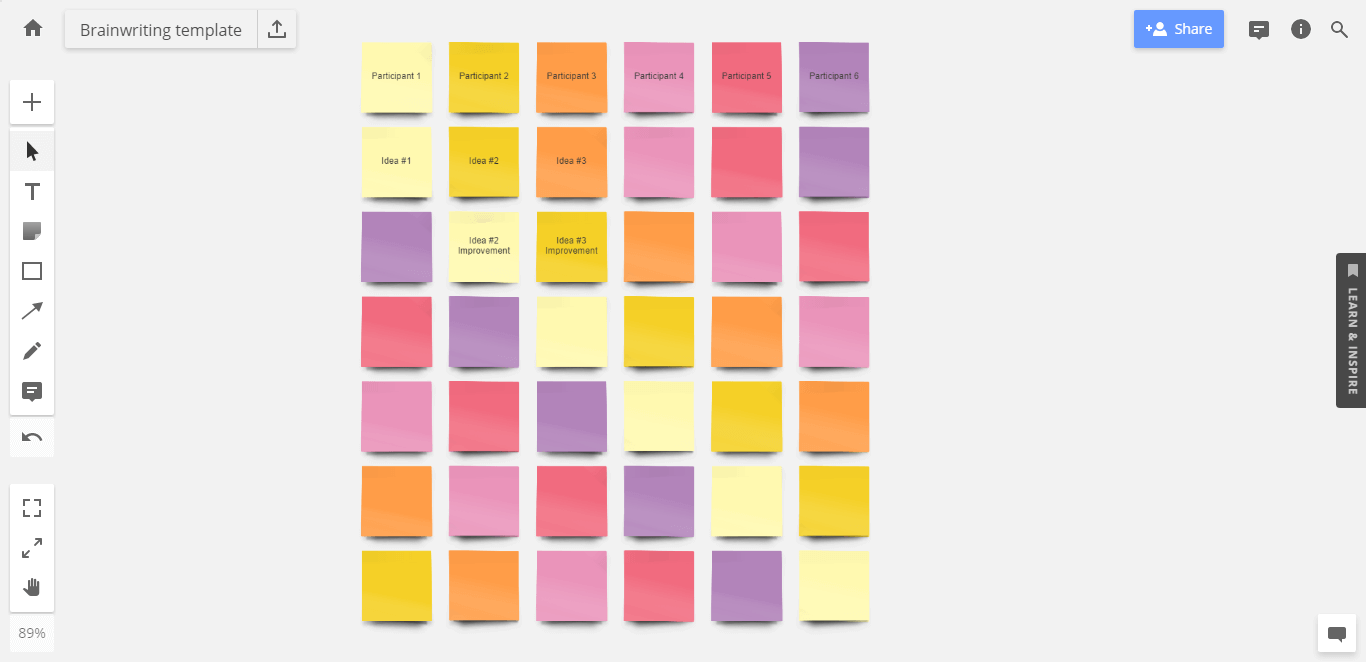
3. Six thinking hats
The six thinking hats is a technique for brainstorming meetings that can be used to break barriers and think outside the box. It requires participants to utilize different perspectives, essentially, trying out a new hat. Here’s a summary of the six hats each team member should try on in this technique.
White Hat — focus on the facts
Yellow Hat — focus on values & benefits
Black Hat — generate possible problems and concerns
Red Hat — apply feeling & emotion
Green Hat — think of something completely new, use creativity
Blue Hat — manage the thinking process to ensure that all the technique guidelines are observed.
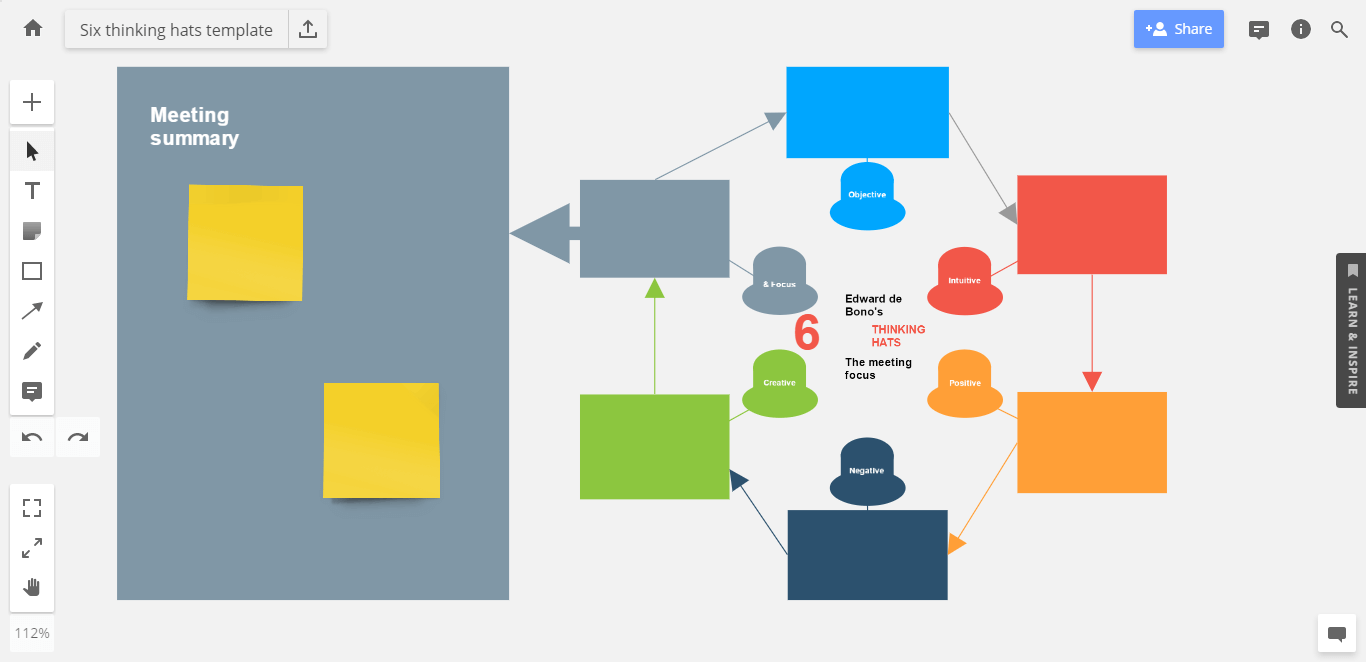
Miro brings this simple six thinking hats method online and allows collaborative brainstorming. Hats are easy to put on and to take off. In a group setting, each member thinks using the same thinking hat, at the same time, on the same thinking challenge. This is referred to as focused parallel thinking.
4. Why? What is stopping you?
You can use this approach when you need not just to generate ideas, but identify the root cause of a problem. This method is similar to the more commonly known as the five whys method, and you even can use the “five whys” template for this technique.
The methodology is simple:
- Add a goal, wish or challenge, to your template
- Ask: “why do you want this?”
- To the response, ask again
- When you feel you found the root of the problem, ask, “What is stopping you?”
Repeating this process to its logical end can help with more concise goal settings.
5. Random words
Random words is a form of free association that breaks down barriers. Gather your brainstorming team on an online whiteboard, put your question/problem in the center of a template and add the first random word as the initial stimul. When the first word is added, ask the contributors to come up with ideas linking the word with a problem or question. They can use online sticky notes to write down as many ideas as come to mind in a short amount of time: one minute is ideal. To generate words, you can use a random word generator or tweets, books etc. Finally, compile the results. Common words may point to something important and outliers may trigger new ideas.
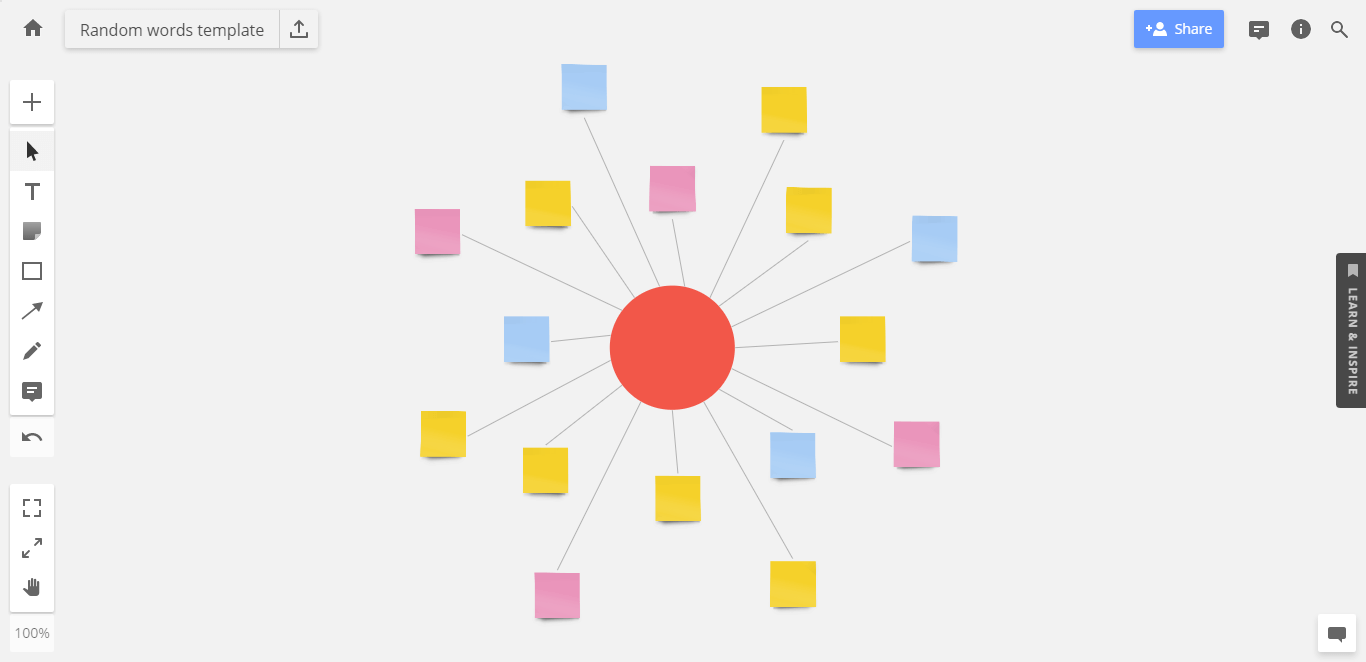
6. Visual association
In random words above, the written word is the driver. In a visual association, an image drives the creativity. Download an image of something that may or may not apply to the current problem. For one minute, let everyone write down any words that they associate with the image. Change several other images. Is there a “sister” word that keeps coming up? Then ask participants to make a connection with the words they have written to the problem indicated. Let this run a little loose and wild. Creativity is king in this technique.
Here’s an example of how to use this technique in a slightly different way from Nancy Halpern: “…try things from the subtraction exercise: e.g. imagine a zoo without the animals….what else could you do with that now empty space? or being inspired by the founder of Nike, who saw a waffle iron and put a similar sole on sneakers (the pairing exercise puts together two unlikely things) — the key is to always tie it back to the business”.
7. Rapid ideation
Rapid ideation is one of the techniques to use when a team has time limitations. In the beginning of the ideation session, the facilitator or team leader provides the context on the deadline, budget limitations, constraints, etc. Time limitations should then be announced for the participants before they start individually write down as many ideas as possible. Depending on the ideation topic complexity, the session can range from 5 to 45 minutes.
We use this technique when we need to create ideas in the middle of a project or preparing for the next sprint. To quickly onboard the team to the ideation topic, we usually share a project board or board with supporting materials one day before the ideation session, so everybody can go through it in advance. A facilitator or a project leader spends no more than 5 minutes to brief the team, following which we can go directly to the ideation stage. People should not worry about filtering their ideas — just generating them, so the project organizer can get many ideas to work on them further.
8. Negative brainstorming
The idea of this technique is to start with finding the worst solutions to the brainstorming topic. Then the team should convert these the worst ideas to relevant, workable solutions. To start your brainstorming session in an unusual manner can be fun!
Adam Schnitzler, Chief Creative Officer of The S3 Agency also suggests to try this technique, “Mix it up. After the first round of ideas slows to a trickle, start another round where everyone tries to think of the worst possible solution to the problem. Collect the bad ideas, have a few laughs, and then see if the group can spin any of the bad ideas into good ones.”
9. Round Robin brainstorming
To get the ideas flowing, Jack Mannion, Account Manager at Terakeet, recommends this technique: “Once you’ve set your pre-session goals, start the brainstorm off by having every member go around in a circle and rapid-fire share ideas. A brainstorm “referee”, or leader, should be recording these ideas. This is a great way to get everyone to start sharing right away, and to spark creativity.”
Curious how to use a circle when everyone isn’t sitting around a boardroom? When using an online whiteboard, all the participants can move in a virtual circle on a whiteboard and announce their ideas through a voice communication.
10. Get into your six year old
This technique of starting your brainstorming session was shared by Jennifer Martin, Founder of Zest Business Consulting: “I generally start a brainstorming session by asking everyone to take off their shoes and any restrictive clothing. Then I bring out coloring books, crayons, and blank paper along with other small toys and I ask the group to play with (or explore) the toys for 5 minutes to help them remember what it felt like to be a kid before they had to be responsible for a lot of decision making. We might even play a game of tag or duck goose to get people moving around like a kid. Then when they’ve really in that kid mind space I ask them to come up with suggestions and possibilities from the perspective of a 5-10 year old (no judgement, just creative solutions)”.
This exercise can be easily adopted for a remote team. Simply replace physical activity by watching a short episode of well-known cartoon or prepare an icebreaking game encouraging everybody to share the game they loved to play most when they were a child.
Bonus. Additional approach from TextMagic
This approach was shared by Alexa Lemzy, Customer Support & Content Manager at TextMagic. They found it effective for brainstorming with remote team members:
1) During the chat, the manager or team leader asks for ideas.
2) The team members ask clarifying questions.
3) After the questions are answered, the team members jot down their suggestions.
4) Everybody shares and discusses their ideas.
This approach allows participants to mull over their suggestions and gain confidence to present different concepts. When everyone starts to share ideas right away, people usually dwell on the first ones listed, just because they’ve attracted the largest portion of their attention. This means that participants tend to think around those few thoughts and ignore the rest.
The list above is designed to make online brainstorming highly productive. These techniques can all be used by remote teams with great success for abundant idea generation.









